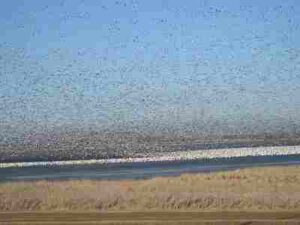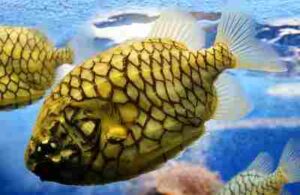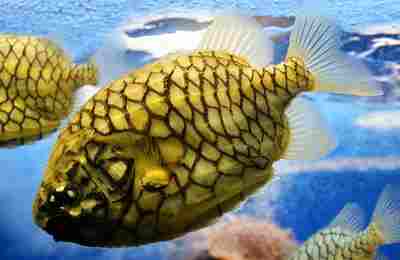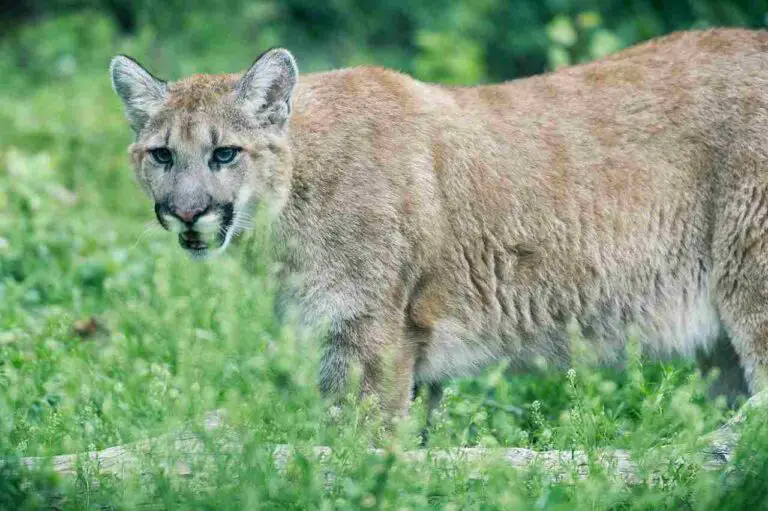7+ Abiotic Factors that Affect Population and Their Significance
Abiotic factors that affect population are; water availability, climatic conditions, sunlight, nutrients, oxygen concentration, physicochemical conditions, habitat availability and suitability, as well as topography.
This article discusses abiotic factors that affect population, and their significance, as follows;
1). Water Availability: One of the Abiotic Factors that Affect Population
Water availability, which is often determined by factors such as precipitation, surface water, and groundwater availability, is an important abiotic factor that significantly influences the dynamics and distribution of populations within ecosystems.
It is pivotal in its role in supporting life, defining habitats, and regulating the populations of various organisms. The significance of water availability and its mechanisms in ecosystems are essential factors for evaluating the challenges and adaptations that organisms undergo in response to fluctuating water conditions. They are discussed in the following subsections.
Significance of Water Availability in Ecosystems
Factors and phenomena that point to the significance of water availability in ecosystems include; survival and reproduction, habitat creation, diversity and community structure, as well as trophic interactions.
Water is essential for the survival of all organisms. It serves as a medium for chemical reactions, facilitates nutrient transport, and is also crucial for various physiological processes. Adequate availability of water is essential for successful reproduction and population maintenance.
Water availability contributes to the formation of various aquatic habitats, such as lakes, rivers, wetlands, and ponds. These habitats support the survival of diverse communities of species, including aquatic plants, fish, amphibians, and aquatic invertebrates.
The presence of water influences the diversity and composition of species within ecosystems. Communities within arid regions may possess specialized adaptations for coping with limited water availability, while those in wetter environments may play host to a wider array of species.
Water availability influences the availability of food resources for species within an ecosystem. The presence or absence of water bodies affects the distribution of prey species, and also influences predator populations.
Mechanisms of Population Alteration through Water Availability
Some mechanisms and phenomena that are highlight the link between water availability and population dynamics include; direct mortality, habitat alteration, migration and dispersal, resource availability, trophic cascades, and physiological adaptations.
Water scarcity and its associated hazards; such as drought conditions, can lead to direct mortality of individuals within populations. Lack of water can cause dehydration, reduced reproduction, and increased vulnerability to other threats.
Changes in water availability can alter habitats. For instance, prolonged droughts can lead to the drying of wetlands, thereby reducing the availability of breeding sites for aquatic animals. Conversely, increased rainfall can create temporary wetlands, thereby providing breeding opportunities for certain species.
Populations may respond to changes in water availability by migrating or dispersing toward areas with more favorable conditions. For example, waterfowl may move to wetlands with higher water levels during dry periods.

Water availability directly affects the availability of food and shelter for species within an ecosystem. In arid environments, species may possess adaptations for water conservation and may exhibit behaviors, such as foraging near water sources, to ensure survival.
Alterations in water availability can lead to trophic cascades. Changes in aquatic habitats can affect the abundance of prey species, thereby influencing the populations of their predators.
Species may develop physiological adaptations to cope with fluctuating water conditions, such as desiccation resistance or the ability to efficiently use water resources. These adaptations influence survival and reproduction.
Human activities, such as water extraction, irrigation, and dam construction, can alter water availability in ecosystems. These activities can have widespread effects on species and populations.
2). Climatic Conditions
Climatic conditions and related phenomena, which encompass factors like temperature, precipitation, humidity, and seasonal variations, are all fundamental abiotic factors that profoundly impact the dynamics and distribution of populations within ecosystems.
These conditions are pivotal with regards to defining the habitats and niches of organisms, influencing their life cycles, behavior, and the overall biological success of their populations. Here is an overview of the significance of climatic conditions; and their mechanisms in ecosystems, both of which are essential for comprehending the responses and adaptations of organisms to changing weather patterns.
Significance of Climatic Conditions in Ecosystems
The significance of climatic conditions in ecosystems can be attributed to concepts like; temperature, energy transfer, precipitation, water availability, seasonal cycles, and climatic zones.
Temperature determines the availability of energy within ecosystems. It affects the rates of various metabolic processes, including growth, respiration and reproduction. Organisms have temperature preferences that influence their distribution and activity.
Precipitation patterns determine the availability of water, which is itself a vital resource for life. Water availability affects habitat formation, reproductive success, as well as the distribution of species, particularly in terrestrial ecosystems.
Seasonal variations in temperature and precipitation lead to the creation of distinct environmental conditions, including summer, winter, wet, and dry seasons. These variations influence the timing of life cycle events, such as breeding, hibernation, and migration.
Lastly, different climate zones, such as tropical, polar, and temperate, are characterized by unique combinations of temperature and precipitation. These zones host distinct communities of species adapted to the local climate.
Mechanisms of Population Alteration through Climatic Conditions
Some mechanisms linked to the alteration of ecological populations through climatic influences, include; survival and reproduction, habitat formation, migration and dispersal, timing of life cycles, resource availability, and phenotypic adaptations.
Extremes in temperature or precipitation can directly impact the survival and reproduction of individuals within populations. Heatwaves, cold spells, or prolonged droughts can lead to direct mortality or reduced reproductive success.
Climatic conditions also influence the formation of specific habitats. For example, the presence of frozen tundra is characteristic of polar regions, while temperate forests tend to thrive in areas with moderate temperatures and rainfall.
As mentioned earlier, populations may respond to seasonal changes or climatic shifts by migrating to areas with more suitable conditions. Birds, for instance, undertake long-distance migrations to find suitable breeding and wintering grounds.
Species have evolved to time their life cycle events, such as flowering, breeding, and migration, in response to climatic cues. Acute changes in climate, such as earlier springs or altered rainfall patterns, can disrupt these timing mechanisms.
Climatic conditions affect the availability of food resources, which can lead to changes in foraging behavior, dietary preferences, and competition among species.
Some species have developed phenotypic adaptations, such as changes in coloration or behavior, to cope with different climatic conditions. For example, animals in cold climates may have thicker fur or feathers.
Lastly, human activities and their repercussions, such as deforestation, environmental pollution, and greenhouse gas emissions, can contribute to shifts in climatic conditions. These human-induced changes can have wide-ranging effects on species and populations.
3). Sunlight: One of the Abiotic Factors that Affect Population
Sunlight, which is a primary source of energy for life on Earth, is an abiotic factor that affects the trends and attributes of populations within various biomes.
Sunlight is key to the sustenance of habitats, as it is involved in driving photosynthesis, and regulating temperature, all of which affect the life cycles, behavior, and success of populations. This implies that the significance of sunlight and its mechanisms in ecosystems are both essential for comprehending the energy flow and adaptations of organisms to varying light conditions.
Significance of Sunlight in Ecosystems
In ecosystems, sunlight is significant as an energy resource and a driver of primary production, temperature regulation, and habitat formation.
Sunlight is the ultimate source of energy in all ecosystems. Through photosynthesis, autotrophic organisms, such as (vascular and non vascular) plants and algae, convert solar energy into chemical bioenergy, which is then transferred through the food web to heterotrophic consumers.
Primary production, which is the process by which autotrophs produce organic matter/biomass from inorganic resources, is driven by sunlight. Primary production forms the foundation of the food chain and supports the energy needs of all organisms in the ecosystem.
Through infrared radiative effects, solar rays influences temperature in ecosystems. These rats warms the environment and affect the availability of thermal energy, which can influence the activity levels and metabolic rates of organisms.

Sunlight availability varies across ecosystems, leading to the formation of different habitat types. For example, tropical rainforest canopies provide shade and create unique microenvironments that support specific populations.
Mechanisms of Population Alteration through Sunlight
Mechanisms and processed linking population dynamics into sunlight availability/intensity include; photosynthesis, habitat differentiation, competition, seasonal changes, thermoregulation, and predator-prey interactions.
The amount of sunlight available affects the rate of photosynthesis in plants and algae. Changes in light energy intensity can lead to alterations in primary production and energy availability for consumers.
Also, organisms may exhibit habitat preferences related to light conditions. For example, shade-tolerant plants and animals thrive in low-light environments, while sun-loving species are adapted to high-light conditions.
Light can be a limiting resource, leading to competitive interactions among species for access to sunlight. Shade-intolerant species may struggle to establish and reproduce in shaded environments due to limited light availability.
Trends of sunlight availability tend to vary with seasons and latitudes. Seasonal shifts in daylight duration can influence the timing of breeding, migration, hibernation, and other life cycle events in populations.
Sunlight is instrumental in thermoregulation by warming or cooling the environment. Organisms may adjust their behavior to maximize exposure to or avoid excessive heat from sunlight.
Predator-prey interactions can be significantly influenced by sunlight. For instance, visual predators may hunt more effectively in well-lit conditions, while prey may have adaptations to reduce visibility or escape predation.
As in other cases, human impacts, such as deforestation, urban development, and pollution, can also alter the availability of sunlight in ecosystems. These alterations can disrupt habitat structure, reduce photosynthesis, and impact populations.
4). Nutrients
Nutrients, including essential elements such as nitrogen, potassium, carbon and phosphorus, are vital abiotic factors that can also influence the dynamics of populations within ecosystems.
Nutrients serve as building blocks for life, impacting primary production, energy flow, and the organic composition of communities. This section highlights the significance of nutrients and their mechanisms in ecosystems, with an aim to understand the biological success, trophic interactions, and evolutionary adaptations of organisms.
Significance of Nutrients in Ecosystems
In ecosystems, the significance of nutrients can be traced to their involvements in primary production, energy transfer, biogeochemical cycling, and habitat quality conditions.
Nutrients are fundamental ingredients for primary production; the biological process by which autotrophic organisms, such as plants and phytoplankton, convert inorganic materials into organic matter through photosynthesis. Primary production is a foundational process of food chains/webs/energy pyramids, and supports heterotrophic consumers.
Similarly, nutrients influence the transfer of energy through ecosystems. By regulating primary production, nutrients determine the availability of energy for organisms in all trophic levels within the food web.
Nutrients are part of biogeochemical cycles, including the nitrogen, phosphorus, and carbon cycles. These cycles govern the movement of nutrients between living organisms, the atmosphere, soil, and water, thereby defining nutrient availability.
Also, nutrient availability can impact habitat quality. For example, nutrient-rich soils support diverse plant communities, which in turn, provide shelter and food resources for animal populations.
Mechanisms of Population Alteration through Nutrients
Mechanisms by which nutrients affect ecological populations can be defined in terms such as nutrient limitation; competition, algal blooms, nutrient recycling, and physiological adaptations.
Nutrient availability can be a limiting factor for primary production. In some ecosystems, nutrient limitation can restrict plant growth, which cascades through the food web and affects consumer populations.
Often, nutrients can be a resource over which organisms compete. Nutrient availability can influence competitive interactions among species, leading to changes in population sizes and distribution.
Excess nutrient input, which may lead to outcomes such as eutrophication from agricultural runoff or sewage, can lead to algal blooms. These blooms can disrupt ecosystems by altering water chemistry, depleting oxygen, and impacting populations of aquatic organisms.
Decomposers are very instrumental in nutrient recycling. The biodegradation of organic matter releases nutrients back into the environment, which can in turn influence primary production and population dynamics.
Some species have developed physiological adaptations to cope with nutrient limitations or excesses. For example, some plants can form mutualistic relationships with nitrogen-fixing bacteria to effectively acquire nitrogen.
Human activities, including agriculture, and manufacturing, can alter nutrient cycles. Excessive nutrient inputs can lead to adverse environmental issues, while nutrient depletion can affect the quality of soils and water.
Through primary production, nutrient availability can influence the composition of plant communities. Changes in plant species composition can, in turn, affect the types of herbivores and their populations.
5). Oxygen Concentration: One of the Abiotic Factors that Affect Population
Oxygen concentration can be described as a crucial abiotic factor that influences the dynamics and distribution of populations within ecosystems.
Adequate oxygen levels are essential for the respiration and survival of most organisms. Variations in oxygen availability can therefore impact the composition and biological performance of communities, metabolic rates, as well as the overall success of populations.
The significance of oxygen concentration and its mechanisms in ecosystems are vital issues discussed here, within the context of adaptations and responses of organisms to changing oxygen conditions.
Significance of Oxygen Concentration in Ecosystems
Concepts pointing to the significance of oxygen in ecosystems include; respiration, aerobic and anaerobic processes, habitat quality, and biochemical dynamics.
Oxygen is necessary for respiration, the process by which organisms extract energy from organic compounds. It fuels metabolic processes, and without sufficient oxygen, organisms may experience reduced energy productivity and impaired growth.
Most organisms rely on aerobic respiration, which requires oxygen. Variations in oxygen levels can determine whether organisms can utilize aerobic respiration or must resort to less efficient anaerobic respiration, which may produce toxic byproducts.
Adequate oxygen concentrations are essential for habitat quality. Aquatic ecosystems, in particular, require dissolved oxygen for the sustenance of fish and other aquatic life. Low oxygen levels can result in the formation of dead zones or anoxic areas, and disrupt populations.

Oxygen is involved in various biochemical processes, including nutrient cycling and the decomposition of organic matter. Changes in oxygen concentrations can affect these processes, impacting nutrient availability and ecosystem health.
Mechanisms of Population Alteration through Oxygen Concentration
Some mechanisms and phenomena that highlight the effect of oxygen concentration on organic populations include; respiratory stress; habitat displacement, metabolism, anaerobic conditions, competition, and climate change.
Reduced oxygen levels can lead to respiratory stress for most organisms, resulting in declines in growth, reproductive rates, and overall vitality. Some species may be more tolerant of low oxygen conditions than others.
Populations may respond to oxygen fluctuations by relocating to areas with more tolerable conditions. For example, fish in aquatic systems may migrate to oxygen-rich zones during periods of low oxygen availability.
Oxygen availability affects metabolic rates. Organisms in low-oxygen environments may reduce their metabolic activity, which can in turn influence growth and reproduction.
In low-oxygen environments, organisms that are able to switch to anaerobic respiration may have an advantage. However, anaerobic respiration can lead to the accumulation of toxic byproducts, eventually affecting population health.
Oxygen availability can influence competitive interactions among species. Organisms that are better adapted to low-oxygen conditions (in anoxic scenarios) may outcompete others, leading to changes in population sizes and distribution.
As in other cases, human activities, such as nutrient pollution, can contribute to oxygen depletion in aquatic ecosystems, causing harm to aquatic populations. Additionally, habitat destruction and other forms of environmental degradation can reduce oxygen availability in terrestrial ecosystems.
Changes in temperature and water chemistry, which are associated with global warming and climate change, can affect oxygen solubility in water bodies, influencing aquatic populations.
6). Physicochemical Conditions
Physicochemical conditions, which encompass various abiotic factors such as pH, salinity, turbidity, temperature, and conductivity, are significant with respect to influencing the dynamics and spatiotemporal distribution of populations within ecosystems.
These conditions have a direct impact on the physical and chemical characteristics of the environment, which, in turn, affect the physiological processes, adaptations, and biological performance of populations.
The significance of physicochemical conditions and their mechanisms in ecosystems are discussed below, in a bid to highlight the ecological interactions and responses of organisms to these variables.
Significance of Physicochemical Conditions in Ecosystems
Factors pointing to the significance of physicochemical conditions in ecosystems can be addressed in terns of physiological constraints, habitat formation, species composition, and trophic interactions.
Physicochemical conditions impose constraints on organisms' physiological processes. Extreme pH, salinity, or turbidity can directly impact any given organism's ability to grow, reproduce, or respire.
The formation of specific habitats is also influenced by physicochemical conditions. For example, high salinity levels create marine habitats, while low pH conditions contribute to acidic wetlands.
Different physicochemical conditions determine the survival and distribution specific species or communities adapted to those conditions. Interaction between physicochemical variables and these unique communities can influence the composition of populations.
Physicochemical conditions can also affect the availability of resources, such as the distribution of prey or the types of available food. Changes in resource availability can impact predator-prey dynamics and population sizes.
Mechanisms of Population Alteration through Physicochemical Conditions
Different mechanisms drive population changes within the context of physicochemical influence, including physiological stress, habitat adaptations, habitat selection, competition, migration, and (altered) trophic interactions.
Extreme or suboptimal physicochemical conditions can cause physiological stress in organisms. This stress can lead to reduced growth, reproductive success, and survival.
Populations may evolve adaptations to cope with specific physicochemical conditions. For instance, some extremophiles thrive are able to in highly acidic or saline environments.
Populations may exhibit habitat preferences based on physicochemical conditions. This implies that organisms may select areas that match their tolerance for factors like pH, temperature, or salinity.
Physicochemical conditions can influence competition for resources. For example, organisms in hypersaline zones which are adapted to high-salinity environments may outcompete those that cannot tolerate these conditions, while organisms with anaerobic adaptations will perform better in the abyssal marine zone than those lacking such attributes.
As stated earlier, populations may respond to unfavorable physicochemical conditions by migrating toward areas that have more suitable conditions, which leads to changes in population distribution.
Changes in resource availability due to variations in physicochemical conditions can influence trophic interactions, and this may reflect in diverse ways such as shifts in predator-prey dynamics and changes in food web frameworks.
Human interference, which leads to pollution, habitat loss, and land use changes, can alter physicochemical conditions in ecosystems. These alterations can in turn have far-reaching consequences for populations.
7). Habitat Availability and Suitability: Abiotic Factors that Affect Populations
Habitat availability and suitability are fundamental abiotic factors/concepts that are significant in determining the characteristics of populations within ecosystems.
The presence of suitable habitats and the conditions within those habitats directly influence the ability of organisms to thrive, reproduce, and persist.
As in other sections, the significance of habitat availability and suitability, and their mechanisms in ecosystems, are discussed here.
Significance of Habitat Availability and Suitability in Ecosystems
The significance of habitat availability and suitability in ecosystems can be assessed using concepts like shelter and resources, species distribution, biodiversity, and niche specialization.
Habitats provide organisms with essential resources, such as food, water, and breeding sites. The presence of suitable habitats is therefore critical for population survival and growth.
As mentioned earlier, different species have evolved to tolerate and thrive in specific habitats, and the availability of these habitats determines their spatial distribution. Some species may be confined to certain ecosystems, while others are more adaptable and can occupy a broad range of habitats (as is the case for coyotes found in forests, prairies, deserts and urban ecosystems).

The variety and quality of available habitats contribute to biodiversity. What this implies is that diverse habitats support diverse communities of species, leading to a complex trophic network of ecological interactions.
Habitat availability and suitability influence the specialization of niches within ecosystems. Organisms adapt to distinct habitat conditions, developing unique traits and behaviors that allow them to exploit the most tolerable and favorable ecological niches.
Mechanisms of Population Alteration through Habitat Availability and Suitability
Mechanisms and concepts that drive population alteration within the context of habitat availability and suitability, include; population density, habitat selection, resource availability, migration, habitat modification, and competition. Many of these are in turn influenced by human interferences. Below is an outline with further elaboration.
The availability of suitable habitats can limit the population density of species. When habitats are in high demand, organisms may compete intensely for access to these spaces, leading to exclusion of less-competitive groups/individuals.
Populations may exhibit habitat preferences based on factors such as temperature, humidity, or substrate type. Organisms tend to select habitats that align with their ecological requirements and adaptations.
Habitat conditions determine the availability of critical ecologic resources, including food and water. Changes in habitat quality can influence resource abundance and the health of populations.
Populations may respond to changing trends in habitat availability by migrating continuously to areas with more tolerable conditions. Migration can be a mechanism for populations to expand or contract in response to changing habitat availability.
Some species can modify their habitats in order to make them more suitable. For example, beavers construct water dams to create wetland habitats that support their populations and those of other species.
The availability of suitable habitats can influence competitive interactions among species. When habitats are limited, competition for these spaces can lead to changes in population sizes, compositions and distribution.
8). Topography
Topography, which simply refers to the physical characteristics, including geometric outline and geomorphology of the land surface, is an abiotic factor that also influences the dynamics of populations within many ecosystems.
The shape, elevation, slope, and other topographic features of an area help create distinct microenvironments that directly impact the availability of resources, patterns of water flow, and temperature conditions.
This section addresses the significance of topography and its mechanisms in ecosystems, which are essential variables for comprehending the ecological preferences, adaptive development, and biological success of populations.
Significance of Topography in Ecosystems
Concepts that highlight the significance of topography (as an influencer of population dynamics) in ecosystems include; microenvironments, habitat diversity, resource distribution and species zonation.
Topography creates diverse microenvironments within an ecosystem. Variations in elevation, slope, and aspect (or orientation) influence temperature, soil moisture, and light availability.
Also, topography contributes to habitat diversity by shaping the characteristics of different areas. These variations create a mosaic of ecologic habitats that can support different species or communities.
The movement patterns of water and soil nutrients are influenced by topography. These factors determine the distribution of various resources including water, minerals, and organic matter.
Lastly, topography often leads to zonation patterns where different species or populations are distributed along elevation gradients. This creates a structured community organization in ecosystems.
Mechanisms of Population Alteration through Topography
There are various mechanisms and phenomena that link topography to population dynamics. They include; elevation, temperature, microclimates, water flow, soil characteristics, microhabitat preferences, species interactions, migration, and dispersal.
Changes in elevation lead to variations in temperature. Populations may be restricted to specific elevational zones where temperature conditions align with their adaptations.
Topographic features can create microclimates, where local temperature and moisture conditions differ from the broader climate. Populations adapt to these microenvironments.
As stated earlier, the movement of water is influenced immensely by topographic conditions, which create patterns of runoff, streamflow, and groundwater recharge. Populations of aquatic organisms are closely tied to these flow patterns.
Also, topography affects soil properties, including depth, texture, and moisture content. Soil conditions determine plant distribution, which, in turn, influences herbivore populations.
Populations may exhibit preferences for specific microhabitats created by topographic features, such as rock outcrops, cliffs, or sheltered slopes.
Topography can influence species interactions. For example, predators may take advantage of elevation gradients to track prey that seeks refuge at different elevations.
Lastly, topography can act as a barrier or a conduit for species migration and dispersal. Populations may move along elevation gradients or seek refuge in valleys during unfavorable conditions.
Anthropogenic activities, such as land development and deforestation, can alter topography. These alterations in turn can disrupt ecosystems and impact the populations that occur within them.
Conclusion
Abiotic factors that affect population include;
1. Water Availability
2. Climatic Conditions
3. Sunlight
4. Nutrients
5. Oxygen Concentration
6. Physicochemical Conditions
7. Habitat Availability and Suitability
8. Topography





